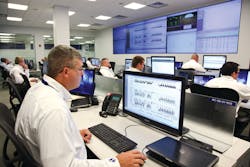You have aircraft all over the world, some in fragile, precarious, hostile environments. These aircraft are essential for getting material and personnel deployed, evacuated, and repositioned. Your local techs are attached to these air assets and carry the brunt of the work; but they have limited resources and limited flexibility in their repairs – and they’re 11 time zones away from the people with the ultimate answers. How do you help them?
In early October 2012, Rolls-Royce unveiled its newest Defense Operations Center in downtown Indianapolis. With its defense business representing some 20 percent of Rolls-Royce revenue, that 40,000-employee company is committed to servicing products that are located around the world. Many have extremely long life cycles (the T-56 turboprop, a version of which powers the C-130 Hercules transport, began life in 1952 – 60 years ago; that’s more than half the lifespan of powered flight!), yet they are supplying the front lines.
Of course, Rolls-Royce has “Service Delivery Centers” located on major bases. They provide local inspection and monitoring; they are a part of Rolls-Royce’s Globalized Mission Care Support. However, they are limited to “by the book” support. When something unusual or particularly complex arises, or when an authorization for a quick fix/off-label solution is necessary, another level of help or authorization is required. That comes from the Operations Centers.
Field backup
On the civil-aircraft side Rolls-Royce has TotalCare. The defense side of the business has a similar program, called Mission Care. Paul Craig, president, Defense Systems, explains both programs, from the customers’ point of view: “With these programs, you know what you’re going to spend; the [cost] risks transfer to Rolls-Royce.” He adds, “The principle is not complicated … but the product can be. Our on-base Service Delivery Centers put our footprint wherever the customer is, and this center is the high-level backup for our people in the field.”
The Indianapolis Defense Operations Center is the second of its type in the world, and the first in the U.S. It provides worldwide 24/7 support for all Rolls-Royce defense products and systems – nacelles, gearboxes, engines, APUs – and helps with questions relating to the interactions of adjacent systems, like propellers, some refueling equipment, even fuel-use analysis, to optimize load/range equations.
Typically, service runs from the first callout to the local (base) service department. If it escalates, it may go to a regional rep, and then to Indianapolis. However, it is also possible to skip this chain of communication; backed by sufficient urgency, the pilot can call the center directly. One more step of urgency exists in the military (as opposed to civilian) sphere: in the direst of conditions, nobody needs to call anybody – just get the ship into the air, and sort it out later!
Military operations range from that direst of conditions to near-civilian levels of support. Craig says, “The [Navy’s] T-45 training is probably the most-parallel to the civil market, with its regimented usage and planned flights.” Others, not so much. During the crisis in Libya, for instance, the RB199 engines in the Tornado put in some 50 percent greater usage than ever planned; yet these engines enjoyed 100 percent availability throughout the operations. The EJ200 (Typhoon) engines averaged over seven hours per sortie, clocking over 6,000 fleet hours – with 100 percent availability. “Whereas, in broad terms, we emphasize [minimum] parts sales in the civil market, in defense, we maximize availability,” notes Craig.
Though the civil and defense divisions are separate, both benefit from some 80 percent parts commonality in major systems. This is synergistic, from both the experience and parts viewpoints; experience in one sphere, whether manufacturing, support, or engineering, supports the experience in the other.
USMC Major General Walters, speaking at the opening of the center, put the importance of air support in perspective: “We got our first call at 2200 hours on a Friday. Within 36 hours, we had eight jets ready to go. All eight took off; we needed only six, so two turned back. The day after that, we were in Afghanistan, beating back the Taliban … When we have aircraft overhead, we save [our] lives, and take their [Taliban] lives.
Air support
“Ask the Lance Corporals if they like ‘air.’ In their 20-year-old minds, if it weren’t for air support, they wouldn’t be with us any longer. [From my perspective], without air support, we would have at least three times the casualty rate, in both KIA and WIA [killed and wounded in action]. Without air, the Taliban has the advantage.” The combat veteran continued, “If [our Marines] run out of ammunition or water, the conditions get critical. Air support brings these to our Marines. With our program, we need to get everything possible out of every aircraft. Our pilots know that if they get into [a combat zone], they can get out. We have a 98 percent success rate, evacuating our wounded. Aircraft are the only way to do that [in AFG].”
Brian Bowyer, a Marine stationed at Miramar, one of the 150 field service representatives (FSRs) that works on the Osprey, says that “this center saves money and time. Our flight data go straight to the subject matter expert in Indy; there is no need to know ‘whom to call,’ problem by problem. We don’t bother the Ops Center if we know what to do; maybe we’ll make only a few calls a week.”
Interactive tools
Back in the Center, Kelly Thomas, project manager, showed our group of reporters some of the tools that are available, like the interactive monitor. IT maven Kevin Crawford took over, and demonstrated a live borescope examination – several thousand miles away. Curt Morris, a 16-year Rolls-Royce veteran who also has 22 years in the Navy (and 36 total, with just the T-56), noted that boxes of manuals are all on tablets now – the manuals, the IPC (illustrated parts catalog), training, and engine monitoring system. “It’s all on the tablet,” he said. Rolls-Royce uses ruggedized Windows-based tablets; the iPad “is being evaluated.”
Even at the Operations Center, tasks are split, in a form of triage (that would be more accurately called, “duage”). Jeff Hildebrand, the manager of the Operations Center and a service engineer himself, notes that most service questions are handled on-base. A small percentage make it to the Operations Centers, where 80 percent are handled by the generalists, materials specialists; and safety, design, and controls engineers always available there. The final 20 percent are referred to the “back office,” where the specialists lurk, on-call, 24/7. Hildebrand says, “Our objective here (at the Ops Center) is to cover most of these questions within the room. We use a systematic rotation [through the center] from the field; FSRs come in for one-month assignments.” He says that the rotation helps both groups – field and center ops – to understand each others’ capabilities and limitations.
Hallway as classroom
Going through the facility, one is impressed by the balance between openness and security. In the hallway that passes by the engineering bullpen, one sees nothing but frosted-glass walls. At the touch of a hand-held control, a guide can display high-resolution images of engines or systems on these walls – and use computer graphics capabilities to rotate, zoom, and explore these images – the hallway itself is a classroom. Another touch of the control makes the walls transparent; one can then see the center itself, with the call board and certain documents and pages of manuals displayed on huge screens.
The collaborative design of the bullpen’s setup thus allows several engineers to work together from the same document, when necessary. Two or three may be working one problem, even as the rest of the room’s population helps the field, one-on-one.
Though the center had been open for only three months prior to our visit, Hildebrand says that more than 95 percent of customer requests “were met in a timely manner.” That’s not bad for a brand-new operation, especially one where only the trickiest problems even arrive at the center, since the inputs nearly always come from well-trained, experienced FSRs.
Still, this is warfighting, and in war operations, availability is everything. Quick, solid support makes victory possible. Marine Major General Walters concluded, “Centers like this keep these aircraft flying. We have small deployments; every aircraft counts. Your response here is critical to our national security.”
Tim Kern is an aviation writer, aircraft builder, and private pilot. He is based in Anderson, IN, and can be reached at [email protected].
About the Author

Tim Kern
Tim Kern is an aviation writer, aircraft builder, and private pilot. He is based in Anderson, IN, and can be reached at [email protected].
Tim Kern, CAM, MBA, has written for over 50 aviation publications, and is a consultant for a variety of companies; www.timkern.com.
